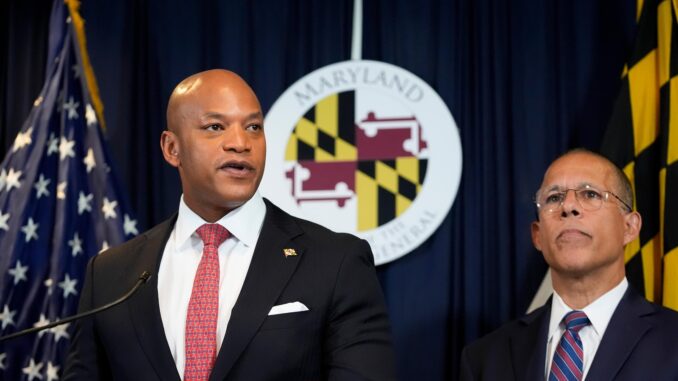
BALTIMORE — The state of Maryland has added to the legal troubles facing the owner and operator of the container ship Dali, which caused the deadly collapse of the Francis Scott Key Bridge in March after the massive vessel experienced an ill-timed electrical blackout and a series of other failures.
Officials announced a new lawsuit Tuesday that echoes several other recent filings alleging the ship’s Singapore-based owner and manager, Grace Ocean Private Ltd. and Synergy Marine Group, knowingly sent an unseaworthy ship into U.S. waters.
“Hear me loud and clear. What happened in the early morning of March 26 should never have happened,” Gov. Wes Moore said at a news conference. “A bridge that was used by thousands of vehicles every single day should still be here right now. A key artery to the Port of Baltimore, which helped move billions of dollars of freight every single year, should still be here right now. And the six victims of the collapse should all be here right now.”
Six construction workers were killed when the ship rammed into one off the bridge’s supports, causing the span to topple into the water. Their families have also sued the companies.
A suit filed last week by the U.S. Department of Justice provided the most detailed account yet of the cascading series of failures on the Dali that left its pilots and crew helpless in the face of looming disaster. That complaint alleges mechanical and electrical systems on the massive ship had been “jury-rigged” and improperly maintained, culminating in a power outage moments before it crashed into one of the bridge’s support columns.
Darrell Wilson, a Grace Ocean spokesperson, declined to comment specifically on the new lawsuit. He said the ship’s owner and manager “look forward to our day in court to set the record straight.”
FBI agents boarded the Dali in April amid a criminal investigation into the circumstances leading up to the collapse. Agents boarded another container ship managed by Synergy while it was docked in Baltimore on Saturday.
The Dali was leaving Baltimore for Sri Lanka when its steering failed because of the power loss. Six men on a road crew, who were filling potholes during an overnight shift, fell to their deaths as the bridge crumbled beneath them. The collapse snarled commercial shipping traffic through the Port of Baltimore for months before the channel was fully reopened in June.
Grace Ocean and Synergy filed a court petition days after the collapse seeking to limit their legal liability in what could become the most expensive marine casualty case in history.
Since then, a number of entities have filed opposing claims, including Baltimore’s mayor and city council, survivors of the collapse, local businesses and insurance companies. They’ve all been consolidated into one liability case and the deadline for most claims to be filed is Tuesday.
The judge, however, issued an order Tuesday extending the deadline for claims related to damaged cargo.
The state’s claim seeks punitive damages against the companies as well as costs associated with cleaning up the wreckage and rebuilding the bridge. It also cites lost toll revenues, environmental contamination, damage to the state’s natural resources and other damages. Officials said they’re still working to quantify the total monetary loss.
“We will not allow Marylanders to be left with the bill for the gross negligence, mismanagement and incompetence that caused this harm,” Maryland Attorney General Anthony Brown said at Tuesday’s news conference. “No one can deny that the Dali’s destruction of the Key Bridge has caused just that: tremendous pain and suffering that will continue for years to come.”
While the ship experienced a series of electrical issues before and after it departed Baltimore, the blackout that occurred as it approached the bridge “was the result of a loose connection in the electrical switchboard,” attorneys for the state wrote in their complaint. They allege that the loose connection resulted from damage caused by the excessive vibrations on the Dali that were also detailed in the Justice Department claim.
Engineers on the ship manually restored its power by reconnecting the tripped breakers, but it again switched off because of a problem with the fuel pumps. Attorneys for the state allege that the fuel supply to the ship’s generators was improperly reconfigured as a cost-cutting measure after Grace Ocean purchased it in 2017.
The ship also experienced power outages while it was still docked in Baltimore. Those blackouts fall into a category of maritime mishaps that must be reported to the U.S. Coast Guard, which authorities say never happened. The Dali’s crew also failed to report the earlier power outages to the two Maryland pilots who boarded the ship upon its departure from Baltimore to guide it through the Chesapeake Bay and into open waters.
The cascading series of failures can all be traced back to Grace Ocean and Synergy, state officials alleged.
“They failed to make sure the ship was seaworthy,” Brown said. “They failed to maintain the electrical equipment necessary to make sure the ship would not lose power. They failed in circumventing critical safety features that should have restored power before the fatal crash occurred. They failed to properly hire and train their crew, and they failed to put adequate procedures in place to ensure this disaster could not happen. In doing so, of course, they failed Marylanders most of all.”


Be the first to comment